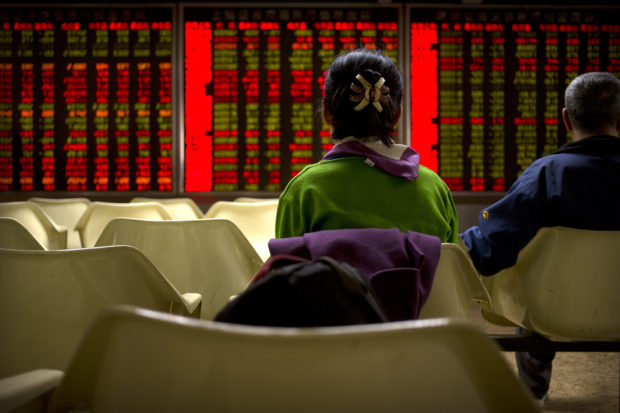
Chinese investors monitor stock prices at a brokerage house in Beijing, Wednesday, March 20, 2019. Markets in Asia are mostly lower after a lackluster day of trading on Wall Street.(AP Photo/Mark Schiefelbein)
BANGKOK — Markets in Asia are mostly lower after a lackluster day of trading on Wall Street.
Mixed signals on the progress of China-U.S. trade talks also revived caution in Chinese markets. The Shanghai Composite lost 1 percent to 3,059.17 in early trading Wednesday and Hong Kong’s Hang Seng fell 0.5 percent to 29,318.53.
Japan’s Nikkei 225 index edged 0.1 percent higher to 21,577.82, while the S&P ASX 200 gave up 0.1 percent to 6,177.50.
South Korea’s Kospi sank 1.1 percent to 2,154.23.
Shares were higher in Taiwan, Thailand and Indonesia but fell in Singapore.
Investors are looking ahead to the Federal Reserve’s interest rate policy update due later Wednesday. The central bank has signaled that it will be “patient” in raising interest rates.
“Against the backdrop of heightened concerns over U.S.-China trade and ahead of the Fed meeting, Asia markets may well trade cautiously once again,” Jingyi Pan of IG said in a commentary. She added that “the broad sense is that regional markets will be attuned toward the Fed meeting.”
U.S. stock indexes closed mostly lower Tuesday after a late-afternoon splash of selling erased early gains, ending a weeklong rally.
Banks accounted for much of the decline, along with utilities and industrial companies. Those losses offset gains in health care, technology and consumer products stocks.
The benchmark S&P 500 ended barely lower, losing less than one point to 2,832.57, its second loss over the past seven trading days. It’s still up 13 percent so far in 2019.
The Dow Jones Industrial Average dropped 0.1 percent to 25,887.38. The Nasdaq composite gained 0.1 percent to 7,723.95, while the Russell 2000 index of smaller-company stocks gave up 0.6 percent, to 1,554.99.
More stocks fell than rose on the New York Stock Exchange. Major indexes in Europe finished higher.
The Fed has made clear that with a dimmer economic picture in both the United States and globally, it no longer sees the need to keep raising rates as it did four times in 2018.
Among the key factors, besides slower growth, are President Donald Trump’s trade war with China, continually low inflation levels and Prime Minister Theresa May’s struggle to execute Britain’s exit from the European Union.
White House officials said Tuesday that top U.S. trade and economic officials will visit China late next week for another round of negotiations on their dispute over Beijing’s industrial policies and other issues.
Treasury Secretary Steven Mnuchin and U.S. Trade Representative Robert Lighthizer will lead the delegation, Trump administration officials said. The sources spoke on background because they weren’t authorized to comment publicly.
CURRENCIES: The dollar rose to 111.59 Japanese yen from 111.40 yen. The euro slipped to $1.1346 from $1.1351 on Tuesday.
ENERGY: Benchmark U.S. crude oil lost 16 cents to $59.13 per barrel in electronic trading on the New York Mercantile Exchange. It gave up 9 cents to close at $59.29 a barrel on Tuesday. Brent crude, the international standard, slipped 3 cents to $67.58 a barrel. /gsg